Artificial Structural Color Pixels: A Review
Abstract
:1. Introduction
2. Photonic Crystal Color Pixels
2.1. Structural Colors Observed in Nature
2.2. Reflective Photonic Crystal Color Filter Development
3. Plasmonic Assisted Full-Color Devices
3.1. Transmissive Plasmonic Color Filters
3.2. Reflective Plasmonic Color Filters
3.3. Angle-Dependent Color Filters
3.4. Depth Variant Color Filters
3.5. Dynamically Tunable Plasmonic Color Filters
4. Conclusions and Outlook
Acknowledgments
Conflicts of Interest
References
- Chen, Q.; Cumming, D.R.S. High transmission and low color cross-talk plasmonic color filters using triangular-lattice hole arrays in aluminum films. Opt. Express 2010, 18, 14056–14062. [Google Scholar] [CrossRef] [PubMed]
- Barnes, W.L.; Dereux, A.; Ebbesen, T.W. Surface plasmon subwavelength optics. Nature 2003, 424, 824–830. [Google Scholar] [CrossRef] [PubMed]
- Laux, E.; Genet, C.; Skauli, T.; Ebbesen, T.W. Plasmonic photon sorters for spectral and polarimetric imaging. Nat. Photonics 2008, 2, 161–164. [Google Scholar] [CrossRef]
- Ebbesen, T.W.; Lezec, H.J.; Ghaemi, H.F.; Thio, T.; Wolff, P.A. Extraordinary optical transmission through sub-wavelength hole arrays. Nature 1998, 391, 667–669. [Google Scholar] [CrossRef]
- Xu, T.; Wu, Y.K.; Luo, X.G.; Guo, L.J. Plasmonic nanoresonators for high-resolution colour filtering and spectral imaging. Nat. Commun. 2010, 1. [Google Scholar] [CrossRef] [PubMed]
- Wu, Y.-K.R.; Hollowell, A.E.; Zhang, C.; Guo, L.J. Angle-insensitive structural colours based on metallic nanocavities and coloured pixels beyond the diffraction limit. Sci. Rep. 2013, 3, 1194. [Google Scholar] [CrossRef] [PubMed]
- Zeng, B.; Gao, Y.; Bartoli, F.J. Ultrathin nanostructured metals for highly transmissive plasmonic subtractive color filters. Sci. Rep. 2013, 3. [Google Scholar] [CrossRef] [PubMed]
- Si, G.Y.; Zhao, Y.H.; Lv, J.; Wang, F.; Liu, H.; Teng, J.; Liu, Y.J. Direct and accurate patterning of plasmonic nanostructures with ultrasmall gaps. Nanoscale 2013, 5, 4309–4313. [Google Scholar] [CrossRef] [PubMed]
- Liu, Y.J.; Leong, E.S.P.; Wang, B.; Teng, J.H. Optical transmission enhancement and tuning by overlaying liquid crystals on a gold film with patterned nanoholes. Plasmonics 2011, 6, 659–664. [Google Scholar] [CrossRef]
- Park, H.J.; Xu, T.; Lee, J.Y.; Ledbetter, A.; Guo, L.J. Photonic color filters integrated with organic solar cells for energy harvesting. ACS Nano 2011, 5, 7055–7060. [Google Scholar] [CrossRef] [PubMed]
- Lucas, B.D.; Kim, J.; Chin, C.; Guo, L.J. Nanoimprint lithography based approach for the fabrication of large-area, uniformly-oriented plasmonic arrays. Adv. Mater. 2008, 20, 1129–1134. [Google Scholar] [CrossRef]
- Si, G.; Teo, E.J.; Bettiol, A.A.; Teng, J.; Danner, A.J. Suspended slab and photonic crystal waveguides in lithium niobate. J. Vac. Sci. Technol. B 2010, 28, 316–320. [Google Scholar] [CrossRef]
- Wang, X.H.; Akahane, T.; Orikasa, H.; Kyotani, T.; Fu, Y.Y. Brilliant and tunable color of carbon-coated thin anodic aluminum oxide films. Appl. Phys. Lett. 2007, 91. [Google Scholar] [CrossRef]
- Smith, S.J.; Purcell, E.M. Visible light from localized surface charges moving across a grating. Phys. Rev. 1953, 92, 1069–1070. [Google Scholar] [CrossRef]
- Lee, H.S.; Yoon, Y.T.; Lee, S.S.; Kim, S.H.; Lee, K.D. Color filter based on a subwavelength patterned metal grating. Opt. Express 2007, 15, 15457–15463. [Google Scholar] [CrossRef] [PubMed]
- Smolyaninova, V.N.; Smolyaninov, I.I.; Kildishev, A.V.; Shalaev, V.M. Broadband transformation optics devices. Materials 2010, 3, 4793–4810. [Google Scholar] [CrossRef]
- Dutta, N.; Mirza, I.O.; Shi, S.; Prather, D.W. Fabrication of large area fishnet optical metamaterial structures operational at near-IR wavelengths. Materials 2010, 3, 5283–5292. [Google Scholar] [CrossRef]
- Alu, A.; Engheta, N. Emission enhancement in a plasmonic waveguide at cut-off. Materials 2011, 4, 141–152. [Google Scholar] [CrossRef]
- Diest, K.; Dionne, J.A.; Spain, M.; Atwater, H.A. Tunable color filters based on metal-insulator-metal resonators. Nano Lett. 2009, 9, 2579–2583. [Google Scholar] [CrossRef] [PubMed]
- Jiang, X.; Gu, Q.; Wang, F.; Lv, J.; Ma, Z.; Si, G. Fabrication of coaxial plasmonic crystals by focused ion beam milling and electron-beam lithography. Mater. Lett. 2013, 100, 192–194. [Google Scholar] [CrossRef]
- Kaplan, A.F.; Xu, T.; Guo, L.J. High efficiency resonance-based spectrum filters with tunable transmission bandwidth fabricated using nanoimprint lithography. Appl. Phys. Lett. 2011, 99. [Google Scholar] [CrossRef]
- Yokogawa, S.; Burgos, S.P.; Atwater, H.A. Plasmonic color filters for CMOS image sensor applications. Nano Lett. 2012, 12, 4349–4354. [Google Scholar] [CrossRef] [PubMed]
- Ellenbogen, T.; Seo, K.; Crozier, K.B. Chromatic plasmonic polarizers for active visible color filtering and polarimetry. Nano Lett. 2012, 12, 1026–1031. [Google Scholar] [CrossRef] [PubMed]
- Fudouzi, H.; Xia, Y. Photonic papers and inks: color writing with colorless materials. Adv. Mater. 2003, 15, 892–896. [Google Scholar] [CrossRef]
- Si, G.Y.; Zhao, Y.H.; Lv, J.; Lu, M.; Wang, F.; Liu, H.; Xiang, N.; Huang, T.J.; Danner, A.J.; Teng, J.; et al. Reflective plasmonic color filters based on lithographically patterned silver nanorod arrays. Nanoscale 2013, 5, 6243–6248. [Google Scholar] [CrossRef] [PubMed]
- Arsenault, A.C.; Puzzo, D.P.; Manners, I.; Ozin, G.A. Photonic-crystal full-color displays. Nat. Photonics 2007, 1, 468–472. [Google Scholar] [CrossRef]
- Lien, A.; Cai, C.; John, R.A.; Galligan, J.E.; Wilson, J. 16.3″ QSXGA high resolution wide viewing angle TFT-LCDs based on ridge and fringe-field structures. J. Disp. 2001, 22, 9–14. [Google Scholar] [CrossRef]
- Si, G.Y.; Zhao, Y.H.; Liu, H.; Teo, S.L.; Zhang, M.S.; Huang, T.J.; Danner, A.J.; Teng, J.H. Annular aperture array based color filter. Appl. Phys. Lett. 2011, 99. [Google Scholar] [CrossRef]
- Roberts, A.S.; Pors, A.; Albrektsen, O.; Bozhevolnyi, S.I. Subwavelength plasmonic color printing protected for ambient use. Nano Lett. 2014, 14, 783–787. [Google Scholar] [CrossRef] [PubMed]
- Le Perchec, J.; Desieres, Y.; Rochat, N.; de Lamaestre, R.E. Subwavelength optical absorber with an integrated photon sorter. Appl. Phys. Lett. 2012, 100. [Google Scholar] [CrossRef]
- Burgos, S.P.; Yokogawa, S.; Atwater, H.A. Color imaging via nearest neighbor hole coupling in plasmonic color filters integrated onto a complementary metal-oxide semiconductor image sensor. ACS Nano 2013, 7, 10038–10047. [Google Scholar] [CrossRef] [PubMed]
- Si, G.Y.; Leong, E.S.P.; Pan, W.; Chum, C.C.; Liu, Y.J. Plasmon-induced transparency in coupled triangle-rod arrays. Nanotechnology 2014, 26. [Google Scholar] [CrossRef] [PubMed]
- Cheng, F.; Gao, J.; Luk, T.S.; Yang, X. Structural color printing based on plasmonic metasurfaces of perfect light absorption. Sci. Rep. 2015, 5. [Google Scholar] [CrossRef] [PubMed]
- Cheng, F.; Gao, J.; Stan, L.; Rosenmann, D.; Czaplewski, D.; Yang, X. Aluminum plasmonic metamaterials for structural color printing. Opt. Express 2015, 23, 14552–14560. [Google Scholar] [CrossRef] [PubMed]
- Si, G.; Wang, Q.; Lv, J.; Miao, L.; Wang, F.; Peng, S. Interference lithography patterned large area plasmonic nanodisks for infrared detection. Mater. Lett. 2014, 128, 373–375. [Google Scholar] [CrossRef]
- Do, Y.S.; Park, J.H.; Hwang, B.Y.; Lee, S.M.; Ju, B.K.; Choi, K.C. Plasmonic color filter and its fabrication for large-area applications. Adv. Opt. Mater. 2013, 1, 133–138. [Google Scholar] [CrossRef]
- Hu, X.; Sun, L.; Shi, B.; Ye, M.; Xu, Y.; Wang, L.; Zhao, J.; Li, X.; Wu, Y.; Yang, S. Influence of film thickness and nanograting period on color-filter behaviors of plasmonic metal Ag films. J. Appl. Phys. 2014, 115. [Google Scholar] [CrossRef]
- Si, G.; Jiang, X.; Lv, J.; Gu, Q.; Wang, F. Fabrication and characterization of well-aligned plasmonic nanopillars with ultrasmall separations. Nanoscale Res. Lett. 2014, 9. [Google Scholar] [CrossRef] [PubMed]
- Huang, Y.-W.; Chen, W.T.; Tsai, W.-Y.; Wu, P.C.; Wang, C.-M.; Sun, G.; Tsai, D.P. Aluminum plasmonic multicolor meta-hologram. Nano Lett. 2015, 15, 3122–3127. [Google Scholar] [CrossRef] [PubMed]
- Si, G.; Danner, A.J.; Teo, S.L.; Teo, E.J.; Bettiol, A.A. Photonic crystal structures with ultrahigh aspect ratio in lithium niobate fabricated by focused ion beam milling. J. Vac. Sci. Technol. B 2011, 29. [Google Scholar] [CrossRef]
- King, N.S.; Liu, L.; Yang, X.; Cerjan, B.; Everitt, H.O.; Nordlander, P.; Halas, N.J. Fano resonant aluminum nanoclusters for plasmonic colorimetric sensing. ACS Nano 2015, 9, 10628–10636. [Google Scholar] [CrossRef] [PubMed]
- Lee, K.T.; Seo, S.; Guo, L.J. High-color-purity subtractive color filters with a wide viewing angle based on plasmonic perfect absorbers. Adv. Opt. Mater. 2015, 3, 347–352. [Google Scholar] [CrossRef]
- Li, Z.; Butun, S.; Aydin, K. Large-area, lithography-free super absorbers and color filters at visible frequencies using ultrathin metallic films. ACS Photonics 2015, 2, 183–188. [Google Scholar] [CrossRef]
- Mazulquim, D.B.; Lee, K.J.; Yoon, J.W.; Muniz, L.V.; Borges, B.-H.V.; Neto, L.G.; Magnusson, R. Efficient band-pass color filters enabled by resonant modes and plasmons near the Rayleigh anomaly. Opt. Express 2014, 22, 30843–30851. [Google Scholar] [CrossRef] [PubMed]
- Miyata, M.; Hatada, H.; Takahara, J. Full-color subwavelength printing with gap-plasmonic optical antennas. Nano Lett. 2016, 16, 3166–3172. [Google Scholar] [CrossRef] [PubMed]
- Nguyen-Huu, N.; Lo, Y.-L.; Chen, Y.-B. Color filters featuring high transmission efficiency and broad bandwidth based on resonant waveguide-metallic grating. Opt. Commun. 2011, 284, 2473–2479. [Google Scholar] [CrossRef]
- Olson, J.; Manjavacas, A.; Liu, L.; Chang, W.-S.; Foerster, B.; King, N.S.; Knight, M.W.; Nordlander, P.; Halas, N.J.; Link, S. Vivid, full-color aluminum plasmonic pixels. Proc. Natl. Acad. Sci. USA 2014, 111, 14348–14353. [Google Scholar] [CrossRef] [PubMed]
- Park, C.-H.; Yoon, Y.-T.; Shrestha, V.R.; Park, C.-S.; Lee, S.-S.; Kim, E.-S. Electrically tunable color filter based on a polarization-tailored nano-photonic dichroic resonator featuring an asymmetric subwavelength grating. Opt. Express 2013, 21, 28783–28793. [Google Scholar] [CrossRef] [PubMed]
- Park, C.-S.; Shrestha, V.R.; Lee, S.-S.; Kim, E.-S.; Choi, D.-Y. Omnidirectional color filters capitalizing on a nano-resonator of Ag-TiO2-Ag integrated with a phase compensating dielectric overlay. Sci. Rep. 2015, 5. [Google Scholar] [CrossRef] [PubMed]
- Park, H.; Dan, Y.; Seo, K.; Yu, Y.J.; Duane, P.K.; Wober, M.; Crozier, K.B. Filter-free image sensor pixels comprising silicon nanowires with selective color absorption. Nano Lett. 2014, 14, 1804–1809. [Google Scholar] [CrossRef] [PubMed]
- Sun, L.; Hu, X.; Zeng, B.; Wang, L.; Yang, S.; Tai, R.; Fecht, H.; Zhang, D.; Jiang, J. Effect of relative nanohole position on colour purity of ultrathin plasmonic subtractive colour filters. Nanotechnology 2015, 26. [Google Scholar] [CrossRef] [PubMed]
- Tan, S.J.; Zhang, L.; Zhu, D.; Goh, X.M.; Wang, Y.M.; Kumar, K.; Qiu, C.-W.; Yang, J.K. Plasmonic color palettes for photorealistic printing with aluminum nanostructures. Nano Lett. 2014, 14, 4023–4029. [Google Scholar] [CrossRef] [PubMed]
- Tanabe, I.; Tatsuma, T. Plasmonic manipulation of color and morphology of single silver nanospheres. Nano Lett. 2012, 12, 5418–5421. [Google Scholar] [CrossRef] [PubMed]
- Uddin, M.J.; Khaleque, T.; Magnusson, R. Guided-mode resonant polarization-controlled tunable color filters. Opt. Express 2014, 22, 12307–12315. [Google Scholar] [CrossRef] [PubMed]
- Uddin, M.J.; Magnusson, R. Highly efficient color filter array using resonant Si3N4 gratings. Opt. Express 2013, 21, 12495–12506. [Google Scholar] [CrossRef] [PubMed]
- Wang, L.; Ng, R.J.H.; Safari Dinachali, S.; Jalali, M.; Yu, Y.; Yang, J.K. Large area plasmonic color palettes with expanded gamut using colloidal self-assembly. ACS Photonics 2016, 3, 627–633. [Google Scholar] [CrossRef]
- Xu, T.; Shi, H.; Wu, Y.K.; Kaplan, A.F.; Ok, J.G.; Guo, L.J. Structural colors: From plasmonic to carbon nanostructures. Small 2011, 7, 3128–3136. [Google Scholar] [CrossRef] [PubMed]
- Yang, C.; Hong, L.; Shen, W.; Zhang, Y.; Liu, X.; Zhen, H. Design of reflective color filters with high angular tolerance by particle swarm optimization method. Opt. Express 2013, 21, 9315–9323. [Google Scholar] [CrossRef] [PubMed]
- Ye, M.; Sun, L.; Hu, X.; Shi, B.; Zeng, B.; Wang, L.; Zhao, J.; Yang, S.; Tai, R.; Fecht, H.-J. Angle-insensitive plasmonic color filters with randomly distributed silver nanodisks. Opt. Lett. 2015, 40, 4979–4982. [Google Scholar] [CrossRef] [PubMed]
- Ye, Z.; Zheng, J.; Sun, S.; Chen, S.; Liu, D. Compact color filter and polarizer of bilayer metallic nanowire grating based on surface plasmon resonances. Plasmonics 2013, 8, 555–559. [Google Scholar] [CrossRef]
- James, T.D.; Mulvaney, P.; Roberts, A. The plasmonic pixel: Large area, wide gamut color reproduction using aluminum nanostructures. Nano Lett. 2016, 16, 3817–3823. [Google Scholar] [CrossRef] [PubMed]
- Yu, Y.; Chen, Q.; Wen, L.; Hu, X.; Zhang, H.-F. Spatial optical crosstalk in CMOS image sensors integrated with plasmonic color filters. Opt. Express 2015, 23, 21994–22003. [Google Scholar] [CrossRef] [PubMed]
- Zhang, Y.; Liu, Q.; Mundoor, H.; Yuan, Y.; Smalyukh, I.I. Metal nanoparticle dispersion, alignment, and assembly in nematic liquid crystals for applications in switchable plasmonic color filters and E-polarizers. ACS Nano 2015, 9, 3097–3108. [Google Scholar] [CrossRef] [PubMed]
- Zheng, B.Y.; Wang, Y.; Nordlander, P.; Halas, N.J. Color-selective and CMOS-compatible photodetection based on aluminum plasmonics. Adv. Mater. 2014, 26, 6318–6323. [Google Scholar] [CrossRef] [PubMed]
- Joannopoulos, J.D.; Johnson, S.G.; Winn, J.N.; Meade, R.D. Photonic Crystals: Molding the Flow of Light, 2nd ed.; Princeton University Press: Princeton, NJ, USA, 2008; pp. 94–154. [Google Scholar]
- Míguez, H.; López, C.; Meseguer, F.; Blanco, A.; Vázquez, L.; Mayoral, R.; Ocaña, M.; Fornés, V.; Mifsud, A. Photonic crystal properties of packed submicrometric SiO2 spheres. Appl. Phys. Lett. 1997, 71, 1148–1150. [Google Scholar] [CrossRef]
- García-Miquel, H.; Barrera, D.; Amat, R.; Kurlyandskaya, G.V.; Sales, S. Magnetic actuator based on giant magnetostrictive material Terfenol-D with strain and temperature monitoring using FBG optical sensor. Measurement 2016, 80, 201–206. [Google Scholar] [CrossRef]
- Grattan, K.T.V.; Meggitt, B.T. Optical Fiber Sensor Technology: Advanced Applications-Bragg Gratings and Distributed Sensors, 1st ed.; Springer: Boston, MA, USA, 2000; pp. 79–188. [Google Scholar]
- Pavlov, V.V.; Usachev, P.A.; Pisarev, R.V.; Kurdyukov, D.A.; Kaplan, S.F.; Kimel, A.V.; Kirilyuk, A.; Rasing, T. Enhancement of optical and magneto-optical effects in three-dimensional opal/Fe3O4 magnetic photonic crystals. Appl. Phys. Lett. 2008, 93. [Google Scholar] [CrossRef]
- Au, T.H.; Trinh, D.T.; Tong, Q.C.; Do, D.B.; Nguyen, D.P.; Phan, M.H.; Lai, N.D. Direct laser writing of magneto-photonic sub-microstructures for prospective applications in biomedical engineering. Nanomaterials 2017, 7. [Google Scholar] [CrossRef] [PubMed]
- Kekesi, R.; Royer, F.; Jamon, D.; Blanc Mignon, M.F.; Abou-Diwan, E.; Chatelon, J.P.; Neveu, S.; Tombacz, E. 3D magneto-photonic crystal made with cobalt ferrite nanoparticles silica composite structured as inverse opal. Opt. Mater. Express 2013, 3, 935–947. [Google Scholar] [CrossRef]
- Caicedo, J.M.; Pascu, O.; López-García, M.; Canalejas, V.; Blanco, A.; López, C.; Fontcuberta, J.; Roig, A.; Herranz, G. Magnetophotonic response of three-dimensional opals. ACS Nano 2011, 5, 2957–2963. [Google Scholar] [CrossRef] [PubMed]
- Peng, W.; Zhu, S.; Zhang, W.; Yang, Q.; Zhang, D.; Chen, Z. Spectral selectivity of 3D magnetophotonic crystal film fabricated from single butterfly wing scales. Nanoscale 2014, 6, 6133–6140. [Google Scholar] [CrossRef] [PubMed]
- Peng, W.; Zhu, S.; Wang, W.; Zhang, W.; Gu, J.; Hu, X.; Zhang, D.; Chen, Z. 3D network magnetophotonic crystals fabricated on Morpho butterfly wing templates. Adv. Funct. Mater. 2012, 22, 2072–2080. [Google Scholar] [CrossRef]
- Abdi-Ghaleh, R. Dual-channel magnetic field sensors based on magnetophotonic heterostructures. Appl. Opt. 2017, 56, 1561–1565. [Google Scholar] [CrossRef]
- Chakravarty, A.; Levy, M.; Jalali, A.A.; Wu, Z.; Merzlikin, A.M. Elliptical normal modes and stop band reconfiguration in multimode birefringent one-dimensional magnetophotonic crystals. Phys. Rev. B 2011, 84. [Google Scholar] [CrossRef]
- Sadat Parvini, T.; Ansari, N.; Tehranchi, M.M. Design of color filter based on variation of incident angle in defective magneto-optical photonic crystals. Iran. Sci. Soc. Eng. Electromagn. 2015, 3, 1. [Google Scholar]
- Guay, J.-M.; Lesina, A.C.; Côté, G.; Charron, M.; Poitras, D.; Ramunno, L.; Berini, P.; Weck, A. Laser-induced plasmonic colours on metals. Nat. Commun. 2017, 8. [Google Scholar] [CrossRef] [PubMed]
- Tada, H.; Mann, S.; Miaoulis, I.; Wong, P. Effects of a butterfly scale microstructure on the iridescent color observed at different angles. Opt. Express 1999, 5, 87–92. [Google Scholar] [CrossRef] [PubMed]
- Teyssier, J.; Saenko, S.V.; van der Marel, D.; Milinkovitch, M.C. Photonic crystals cause active colour change in chameleons. Nat. Commun. 2015, 6. [Google Scholar] [CrossRef] [PubMed]
- Cho, E.-H.; Kim, H.-S.; Cheong, B.-H.; Oleg, P.; Xianyua, W.; Sohn, J.-S.; Ma, D.-J.; Choi, H.-Y.; Park, N.-C.; Park, Y.-P. Two-dimensional photonic crystal color filter development. Opt. Express 2009, 17, 8621–8629. [Google Scholar] [CrossRef] [PubMed]
- Cho, E.-H.; Kim, H.-S.; Sohn, J.-S.; Moon, C.-Y.; Park, N.-C.; Park, Y.-P. Nanoimprinted photonic crystal color filters for solar-powered reflective displays. Opt. Express 2010, 18, 27712–27722. [Google Scholar] [CrossRef] [PubMed]
- Bardet, R.; Belgacem, N.; Bras, J. Flexibility and color monitoring of cellulose nanocrystal iridescent solid films using anionic or neutral polymers. ACS Appl. Mater. Interfaces 2015, 7, 4010–4018. [Google Scholar] [CrossRef] [PubMed]
- Park, J.-S.; Kim, T.-W.; Stryakhilev, D.; Lee, J.-S.; An, S.-G.; Pyo, Y.-S.; Lee, D.-B.; Mo, Y.G. Flexible full color organic light-emitting diode display on polyimide plastic substrate driven by amorphous indium gallium zinc oxide thin-film transistors. Appl. Phys. Lett. 2009, 95. [Google Scholar] [CrossRef]
- Pursiainen, O.L.J.; Baumberg, J.J.; Winkler, H.; Viel, B.; Spahn, P.; Ruhl, T. Shear-induced organization in flexible polymer opals. Adv. Mater. 2008, 20, 1–4. [Google Scholar] [CrossRef]
- Ponsetto, J.L.; Wei, F.; Liu, Z. Localized plasmon assisted structured illumination microscopy for wide-field high-speed dispersion-independent super resolution imaging. Nanoscale 2014, 6, 5807–5812. [Google Scholar] [CrossRef] [PubMed]
- Jin, E.X.; Xu, X. Obtaining super resolution light spot using surface plasmon assisted sharp ridge nanoaperture. Appl. Phys. Lett. 2005, 86. [Google Scholar] [CrossRef]
- Alekseyev, L.V.; Narimanov, E. Slow light and 3D imaging with non-magnetic negative index systems. Opt. Express 2006, 14, 11184–11193. [Google Scholar] [CrossRef] [PubMed]
- Liu, Y.J.; Si, G.Y.; Leong, E.S.P.; Xiang, N.; Danner, A.J.; Teng, J.H. Light-driven plasmonic color filters by overlaying photoresponsive liquid crystals on gold annular aperture arrays. Adv. Mater. 2012, 24, OP131–OP135. [Google Scholar] [CrossRef] [PubMed]
- Cai, W.; Chettiar, U.K.; Yuan, H.-K.; de Silva, V.C.; Kildishev, A.V.; Drachev, V.P.; Shalaev, V.M. Metamagnetics with rainbow colors. Opt. Express 2007, 15, 3333–3341. [Google Scholar] [CrossRef] [PubMed]
- Poujet, Y.; Salvi, J.; Baida, F.I. 90% extraordinary optical transmission in the visible range through annular aperture metallic arrays. Opt. Lett. 2007, 32, 2942–2944. [Google Scholar] [CrossRef] [PubMed]
- Si, G.Y.; Zhao, Y.H.; Leong, E.S.P.; Lv, J.; Liu, Y.J. Incident-angle dependent color tuning from a single plasmonic chip. Nanotechnology 2014, 25. [Google Scholar] [CrossRef] [PubMed]
- Duempelmann, L.; Casari, D.; Luu-Dinh, A.; Gallinet, B.; Novotny, L. Color rendering plasmonic aluminum substrates with angular symmetry breaking. ACS Nano 2015, 9, 12383–12391. [Google Scholar] [CrossRef] [PubMed]
- Jiang, X.; Leong, E.S.P.; Liu, Y.J.; Si, G. Tuning plasmon resonance in depth-variant plasmonic nanostructures. Mater. Des. 2016, 96, 64–67. [Google Scholar] [CrossRef]
- Liu, Y.J.; Ding, X.; Lin, S.S.; Shi, J.; Chiang, I.; Huang, T.J. Surface acoustic wave driven light shutters using polymer-dispersed liquid crystals. Adv. Mater. 2011, 23, 1656–1659. [Google Scholar] [CrossRef] [PubMed]
- Liu, Y.J.; Hao, Q.; Smalley, J.S.T.; Liou, J.; Khoo, I.C.; Huang, T.J. A frequency-addressed plasmonic switch based on dual-frequency liquid crystal. Appl. Phys. Lett. 2010, 97, 091101. [Google Scholar] [CrossRef]
- Liu, Y.J.; Zheng, Y.B.; Shi, J.; Huang, H.; Walker, T.R.; Huang, T.J. Optically switchable gratings based on azo-dye-doped, polymer-dispersed liquid crystals. Opt. Lett. 2009, 34, 2351–2353. [Google Scholar] [CrossRef] [PubMed]
- Chu, K.C.; Chao, C.Y.; Chen, Y.F.; Wu, Y.C.; Chen, C.C. Electrically controlled surface plasmon resonance frequency of gold nanorods. Appl. Phys. Lett. 2006, 89. [Google Scholar] [CrossRef]
- Dickson, W.; Wurtz, G.A.; Evans, P.R.; Pollard, R.J.; Zayats, A.V. Electronically controlled surface plasmon dispersion and optical transmission through metallic hole arrays using liquid crystal. Nano Lett. 2008, 8, 281–286. [Google Scholar] [CrossRef] [PubMed] [Green Version]
- Si, G.; Zhao, Y.; Leong, E.S.P.; Liu, Y.J. Liquid-crystal-enabled active plasmonics: A review. Materials 2014, 7, 1296–1317. [Google Scholar] [CrossRef] [PubMed]
- Khatua, S.; Chang, W.S.; Swanglap, P.; Olson, J.; Link, S. Active modulation of nanorod plasmons. Nano Lett. 2011, 11, 3797–3802. [Google Scholar] [CrossRef] [PubMed]
- Liu, Y.J.; Dai, H.T.; Sun, X.W. Holographic fabrication of azo-dye-functionalized photonic structures. J. Mater. Chem. 2011, 21, 2982–2986. [Google Scholar] [CrossRef]
- Liu, Y.J.; Su, Y.-C.; Hsu, Y.-J.; Hsiao, V.K.S. Light-induced spectral shifting generated from azo-dye doped holographic 2D gratings. J. Mater. Chem. 2012, 22, 14191–14195. [Google Scholar] [CrossRef]
- Liu, Y.J.; Cai, Z.Y.; Leong, E.S.P.; Zhao, X.S.; Teng, J.H. Optically switchable photonic crystals based on inverse opals partially infiltrated by photoresponsive liquid crystals. J. Mater. Chem. 2012, 22, 7609–7613. [Google Scholar] [CrossRef]
- Liu, Y.J.; Dai, H.T.; Leong, E.S.P.; Teng, J.H.; Sun, X.W. Azo-dye-doped absorbing photonic crystals with purely imaginary refractive index contrast and all-optically switchable diffraction properties. Opt. Mater. Express 2012, 2, 55–61. [Google Scholar] [CrossRef]
- Liu, Y.J.; Zheng, Y.B.; Liou, J.; Chiang, I.-K.; Khoo, I.C.; Huang, T.J. All-optical modulation of localized surface plasmon coupling in a hybrid system composed of photo-switchable gratings and Au nanodisk arrays. J. Phys. Chem. C 2011, 115, 7717–7722. [Google Scholar] [CrossRef] [PubMed]
- Liu, Y.J.; Sun, X.W. Electrically switchable computer-generated hologram recorded in polymer-dispersed liquid crystals. Appl. Phys. Lett. 2007, 90. [Google Scholar] [CrossRef]
- Liu, Y.J.; Sun, X.W.; Liu, J.H.; Dai, H.T.; Xu, K.S. A polarization insensitive 2 × 2 optical switch fabricated by liquid cystal-polymer composite. Appl. Phys. Lett. 2005, 86. [Google Scholar] [CrossRef]
- Duan, X.; Kamin, S.; Liu, N. Dynamic plasmonic colour display. Nat. Commun. 2017, 8. [Google Scholar] [CrossRef] [PubMed]
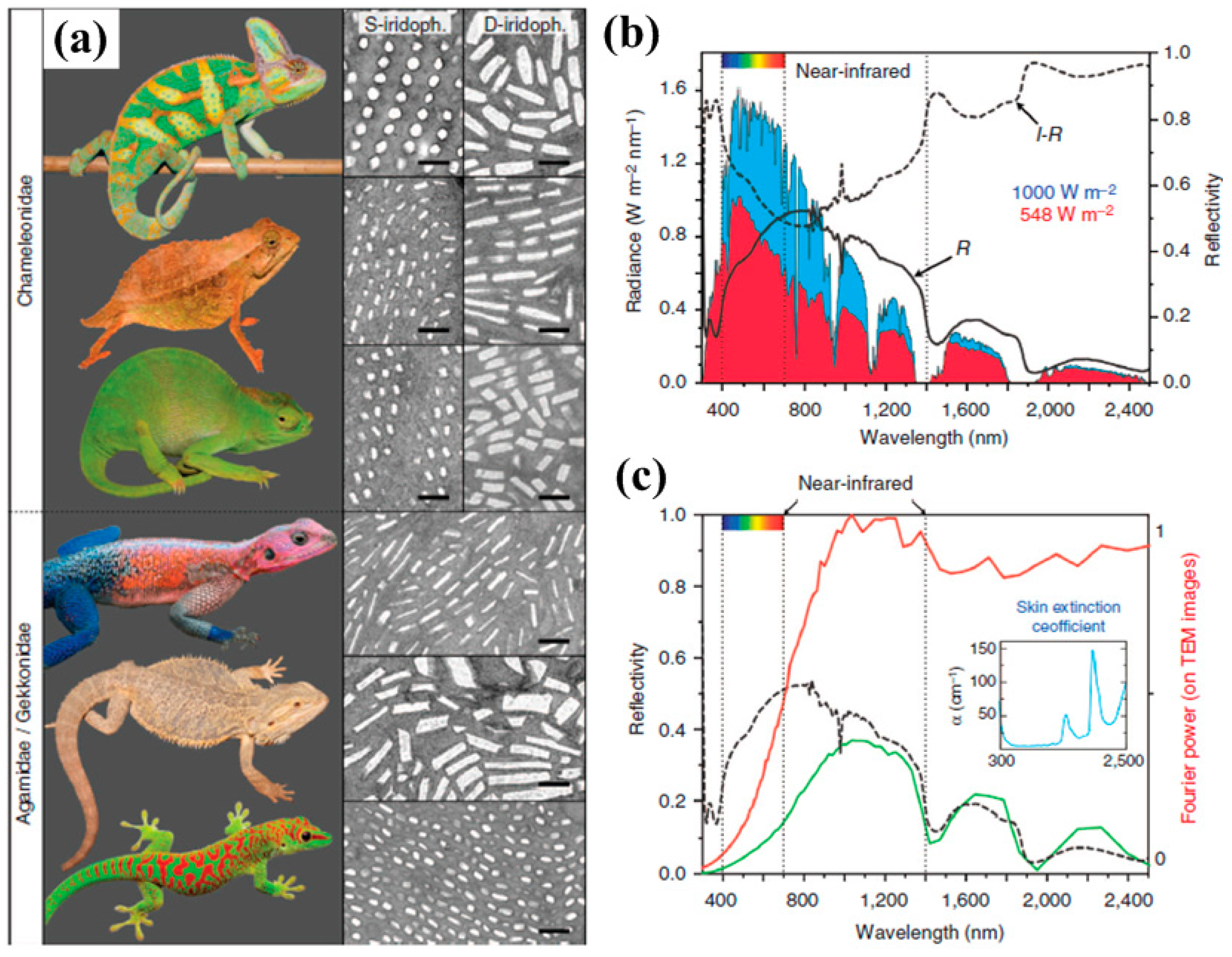

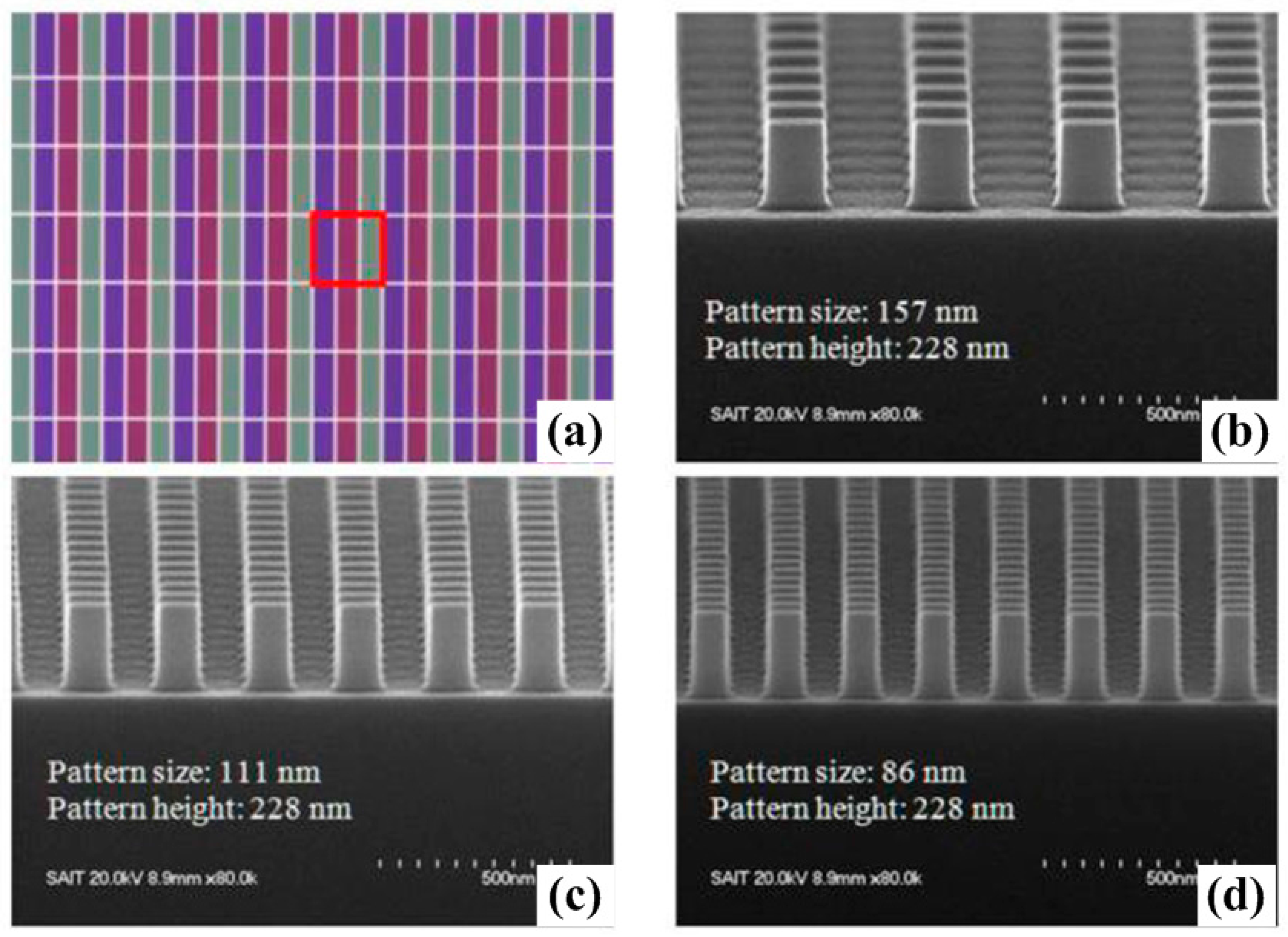
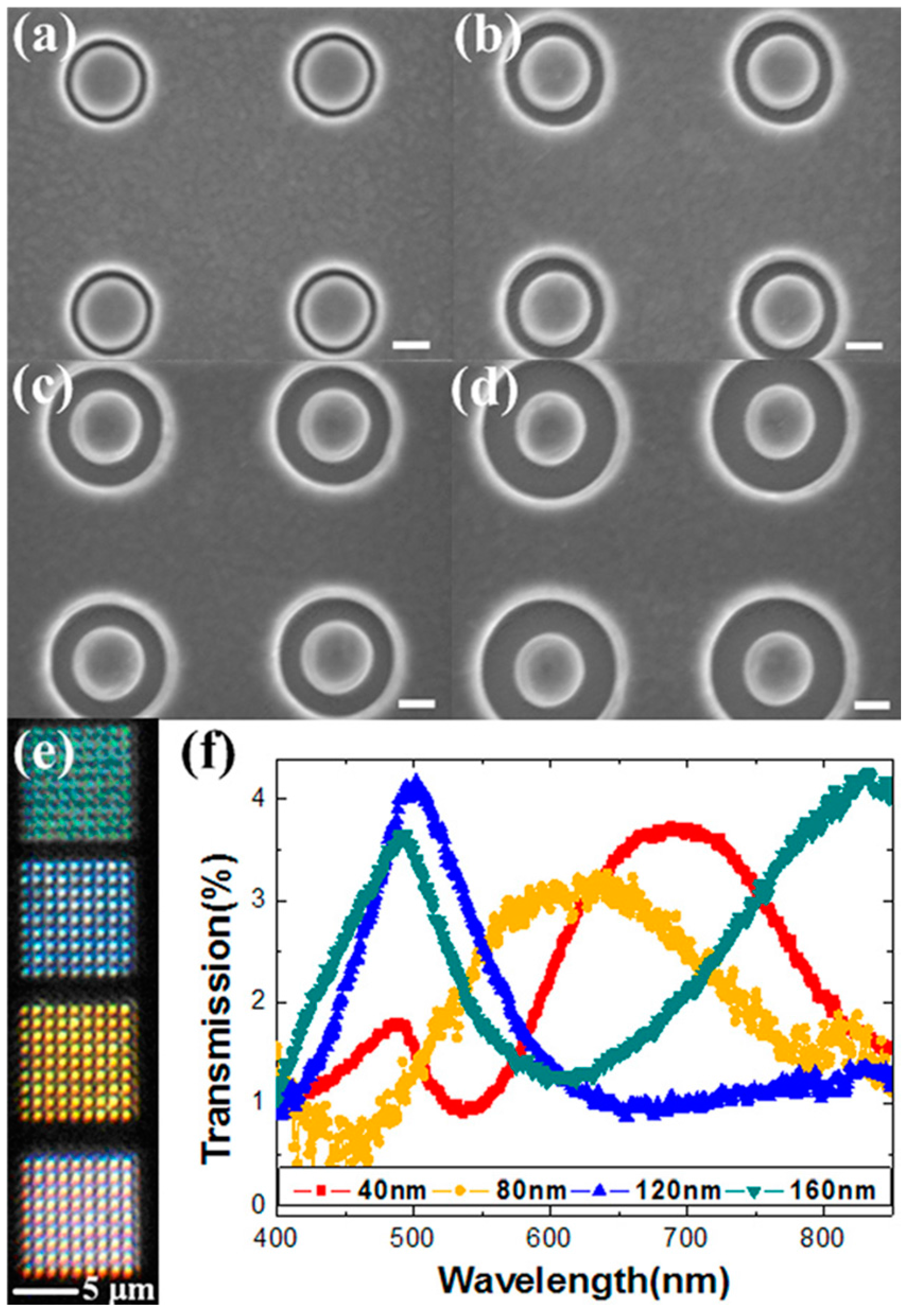
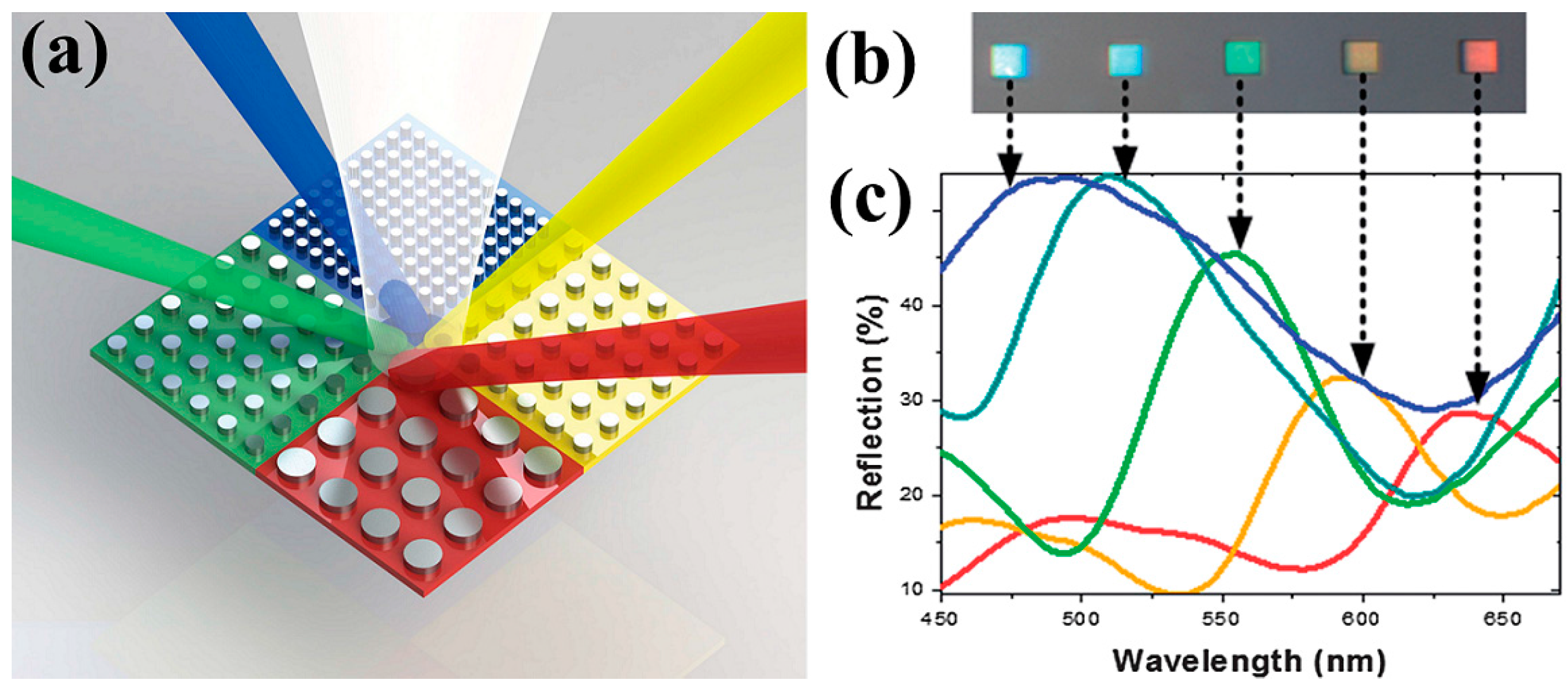
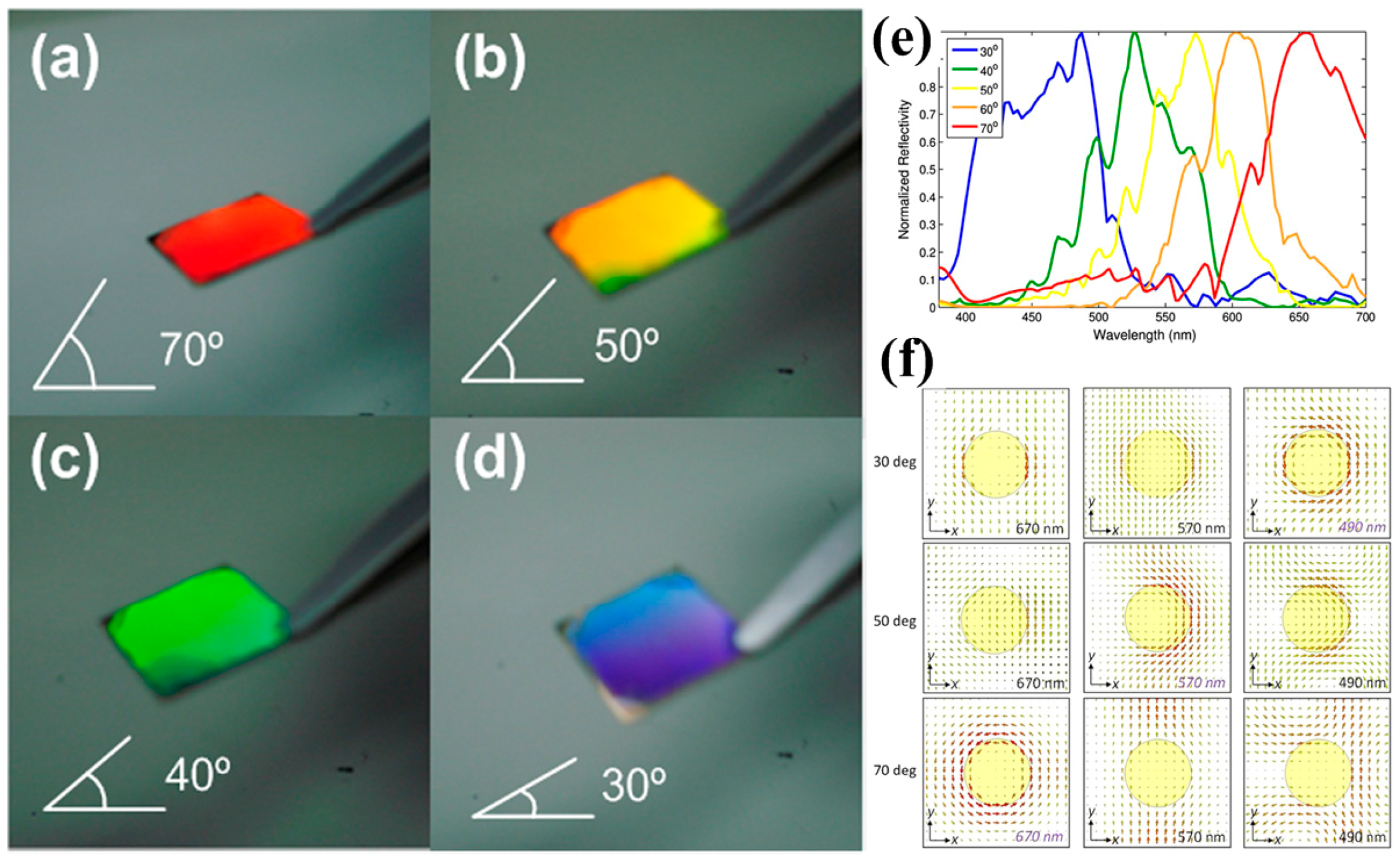
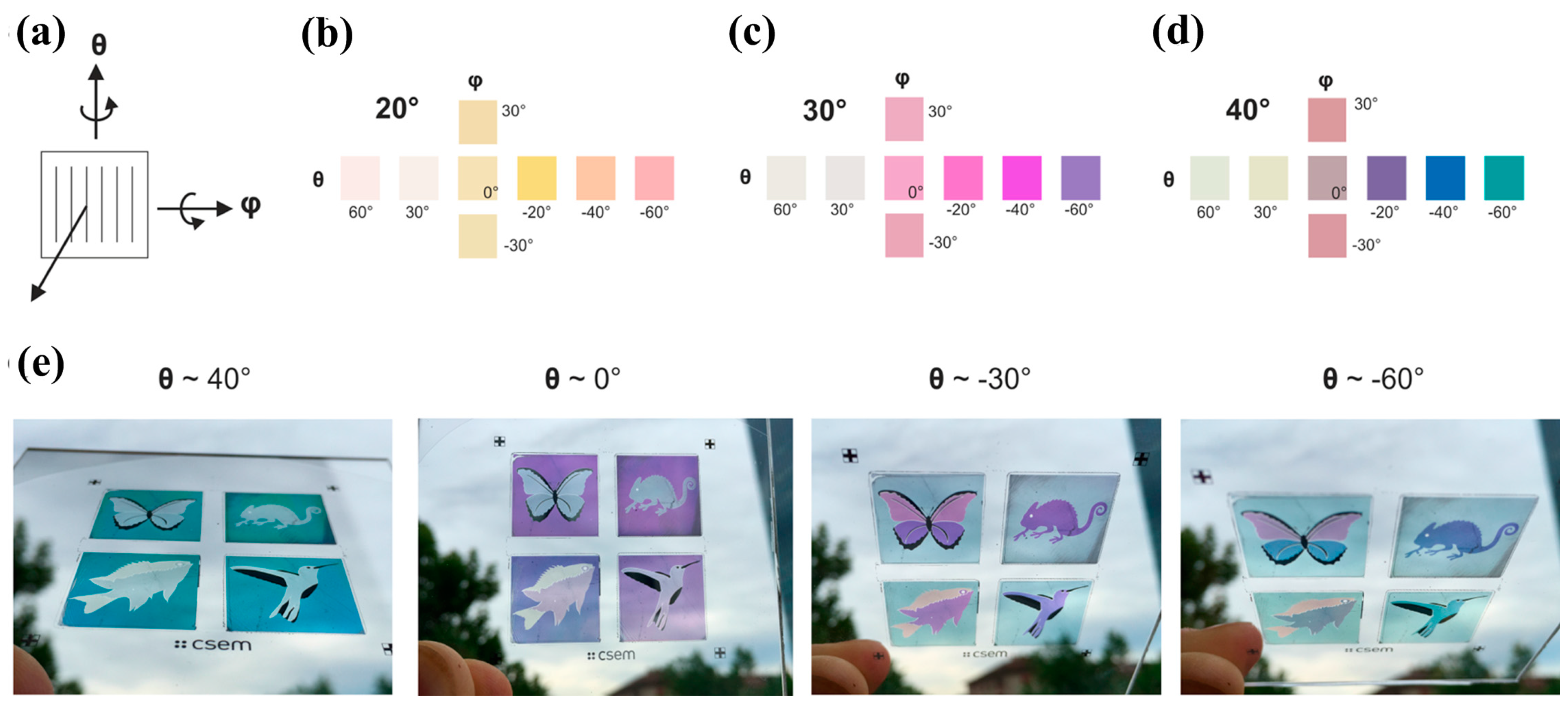
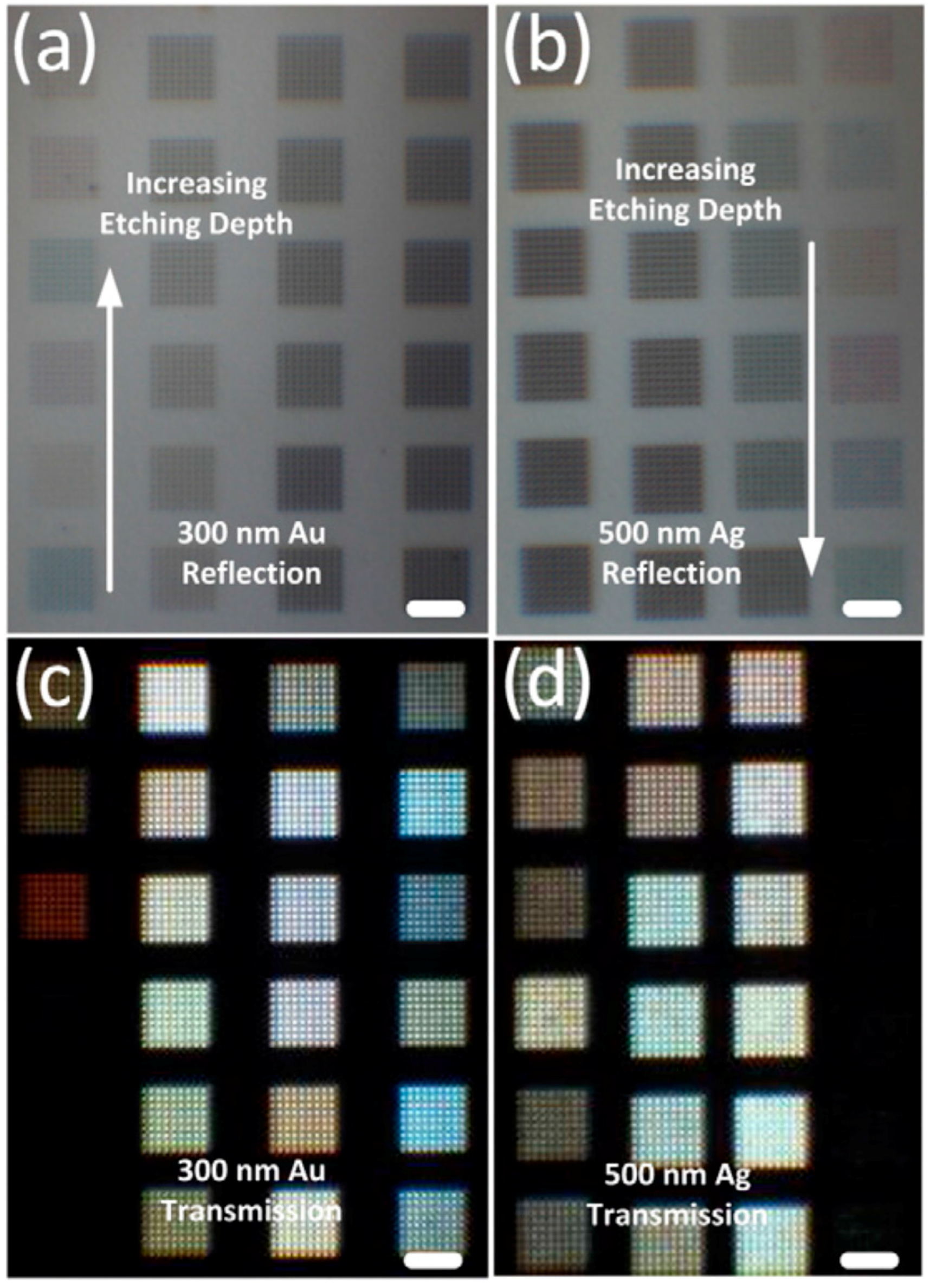
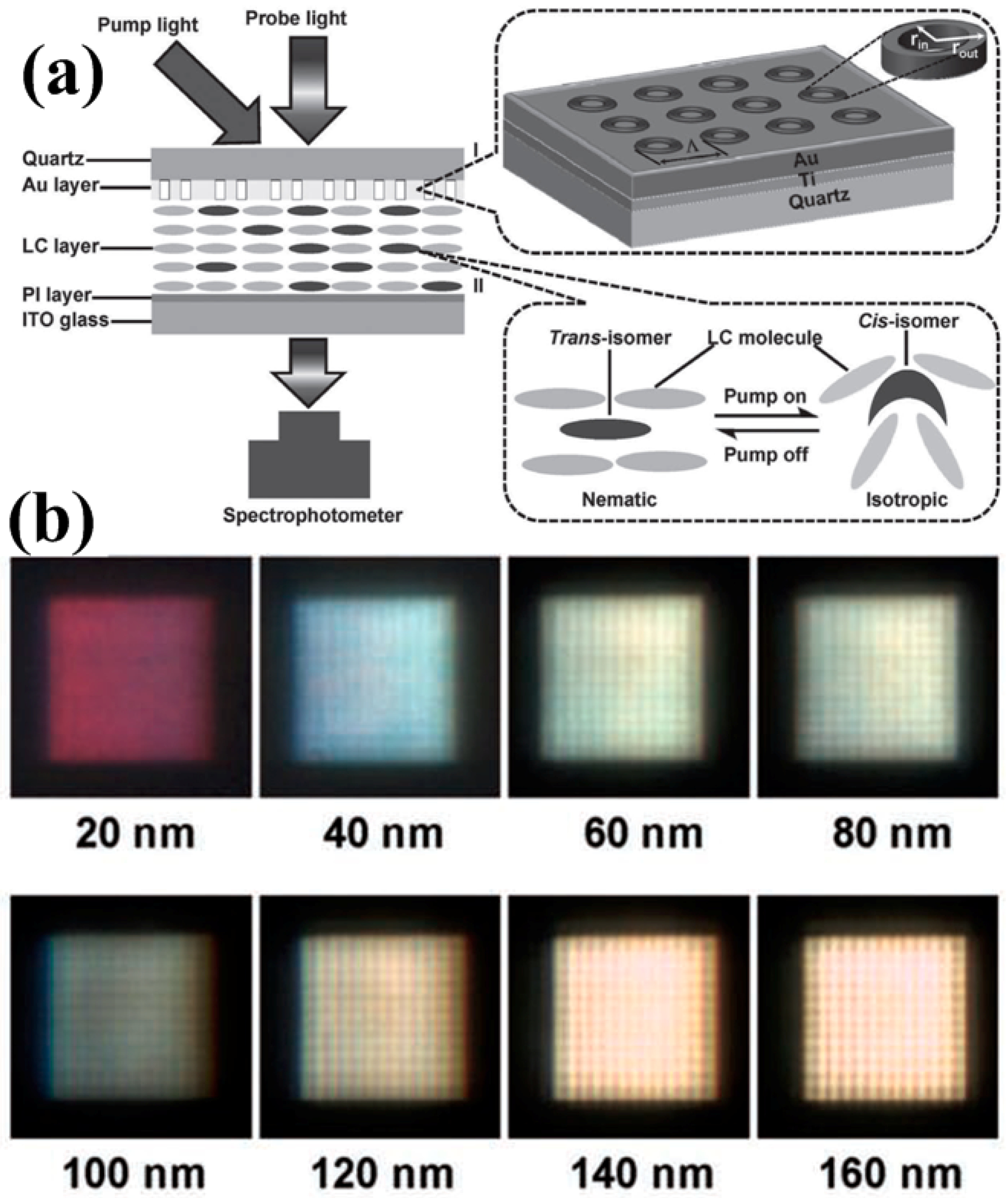

© 2017 by the authors. Licensee MDPI, Basel, Switzerland. This article is an open access article distributed under the terms and conditions of the Creative Commons Attribution (CC BY) license (http://creativecommons.org/licenses/by/4.0/).
Share and Cite
Zhao, Y.; Zhao, Y.; Hu, S.; Lv, J.; Ying, Y.; Gervinskas, G.; Si, G. Artificial Structural Color Pixels: A Review. Materials 2017, 10, 944. https://doi.org/10.3390/ma10080944
Zhao Y, Zhao Y, Hu S, Lv J, Ying Y, Gervinskas G, Si G. Artificial Structural Color Pixels: A Review. Materials. 2017; 10(8):944. https://doi.org/10.3390/ma10080944
Chicago/Turabian StyleZhao, Yuqian, Yong Zhao, Sheng Hu, Jiangtao Lv, Yu Ying, Gediminas Gervinskas, and Guangyuan Si. 2017. "Artificial Structural Color Pixels: A Review" Materials 10, no. 8: 944. https://doi.org/10.3390/ma10080944



